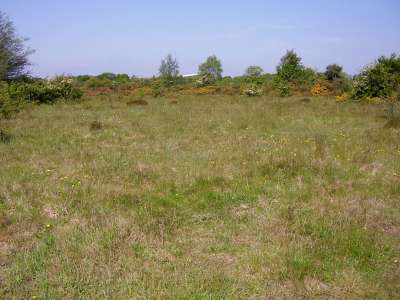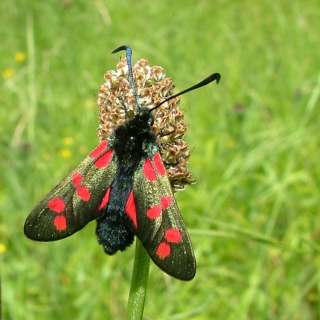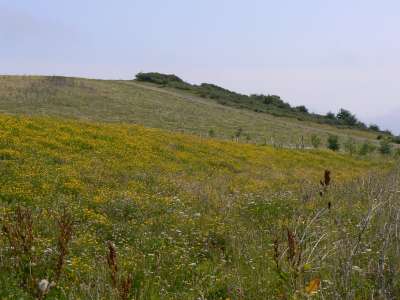
| Butterfly Conservation | |
| saving butterflies, moths and their habitats |
 |
|
|||
| North East England Branch | ||||
|
Brownfield Sites as Butterfly and Moth Habitats. Brownfield sites are sites that have previously been developed, usually for industrial use, but have now been abandoned. In the north east such sites include former colliery working and their associated railway sidings and spoil heaps, old quarries and disused railway lines. Many of these sites have been cleared of industrial buildings and bare ground has been left. 
Many brownfield sites have nutrient-poor or contaminated soils. As a result vegetation develops slowly with flowering plants which are tolerant of such soils, for example bird's-foot trefoil and clovers, colonising quickly. However grasses, which require richer soils, are slow to move in. The best brownfield sites for wildlife are those which are allowed to be colonised naturally, leading to a mixture of short and tall weedy vegetation with patches of bare ground. This slowly develops into grassland, heathland, wetland, scrub and woodland. Heath-like field on former colliery site. Havannah LNR. Some former colliery sites have been developed into local amenities such as country parks. These can provide good butterfly habitats if their redevelopment is well planned. Old quarries usually have thin dry soil with bare patches, warm sunny slopes and scrub such as gorse and hawthorn. On these sites plants such as bird's-foot trefoil and grasses provide caterpillar foodplants for Common Blues, Large and Small Skippers. Disused railway lines provide warm sheltered conditions, and are particularly good places for vanessid butterflies such as Peacocks, Small Tortoiseshells and Red Admirals. Good brownfield sites support a wide range of common butterflies and moths. This is due to their having a variety of habitats and plants. This offers caterpillar foodplants on which the butterflies can lay eggs and good nectar sources on which the adults can feed. Brownfield sites by their very nature are temporary features. If left to develop naturally they will over time become woodland and become unsuitable for butterflies. Therefore management of the habitat such as scrub clearance needs to be done regularly. A greater threat comes from redevelopment. Brownfield sites are often seen as wasteland or an eyesore. They can be prime sites on which to build new housing estates, or old quarries can be turned into landfill sites. Today local authorities are under pressure to redevelop former industrial land and many sites are lost each year to such redevelopment. In fact unless a site has been designated as a nature reserve or country park almost any brownfield site is vulnerable to redevelopment and as a result an interesting habitat and part of the region's biodiversity is lost. Butterflies typically found on brownfield sites: - Common Blue, Small Heath, Meadow Brown, Wall Brown, Large, Small and Dingy Skipper, Small Copper, Orange Tip. Of the scarcer butterflies nearly all of the north east's colonies of dingy skipper and grayling are to be found on brownfield sites. 
Moths typically found on brownfield sites: - Mother Shipton, Six-spot Burnet, Latticed Heath, Shaded Broad-bar, Common and Silver-ground Carpet. Six-spot burnet moth. Photo: J Wallace Some Brownfield Sites in the North East Wingate Quarry - A disused magnesian limestone quarry owned and managed by Durham County Council. Good for Dingy Skippers. NZ372374 Bishop Middleham Quarry - A disused magnesian limestone quarry managed by Durham Wildlife Trust. A good range of butterflies and moths and one of the largest colonies of dingy skippers in the North East. NZ331326 Rising Sun Country Park - A former colliery and quarry just north of Wallsend, managed by North Tyneside County Council. A good range of butterflies particularly Small Skipper. Weetslade Country Park - A former mine and spoil heap east of Wideopen managed by Northumberland Wildlife Trust. It is particularly good for small copper and small skipper. Big Waters - A former mine and subsidence pond near Brunswick Village north of Newcastle managed by Newcastle City Council. Waggonways Network - Many miles of disused railways covering North Tyneside and converted to footpaths and cycle ways. Walbottle Brick Works - A former brick works and quarry between Wallbottle and Newburn west of Newcastle managed by Newcastle City Council. Derwent Valley Country Park - A disused railway stretching nine miles from Blaydon to Consett, managed by Derwentside District Council. Both White-letter and Purple Hairstreaks can be found, but very locally, along it.Waskerley Way - A disused railway stretching from Consett over the moors to Stanhope. 
Former colliery spoil-heap with naturally developing scrub |
| Copyright Butterfly Conservation © 2008 North East England England Branch |
| Privacy and Copyright Statement |
| Butterfly Conservation: Company limited by guarantee, registered in England (2206468) Registered Office: Manor Yard, East Lulworth, Wareham, Dorset, BH20 5QP Charity registered in England & Wales (254937) and in Scotland (SCO39268). |